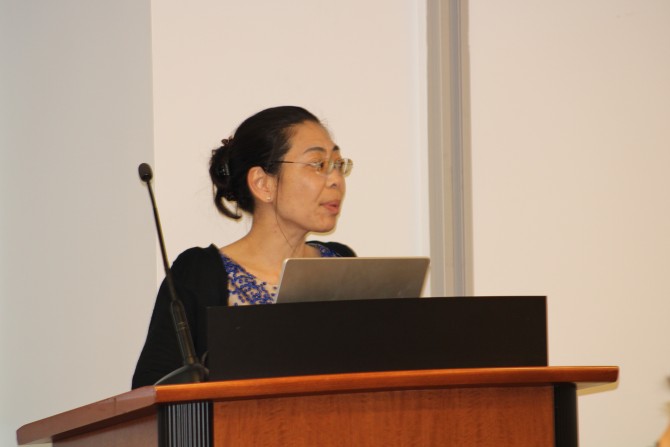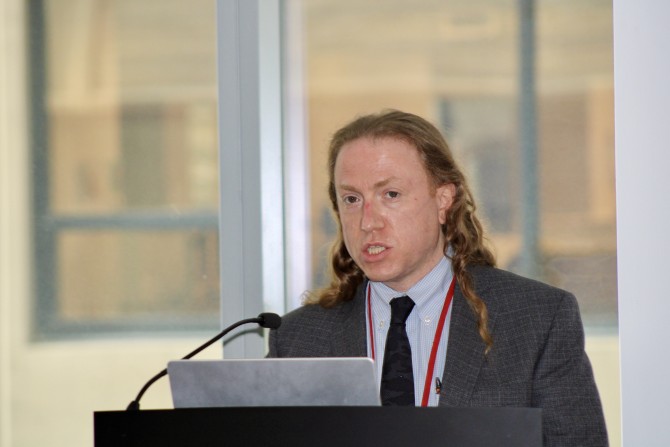
Symposium co-chairs, from left, Marjolein van der Meulen, director of the Meinig School of Biomedical Engineering; Dr. Susan C. Pannullo, director of neurosurgical radiosurgery and neuro-oncology at the Weill Cornell Medicine Brain and Spine Center; and Olivier Elemento, director of the Englander Institute for Precision Medicine.
News directly from Cornell's colleges and centers
Biomedical engineering symposium showcases research, facilitates collaborations
By Peter Cleary
A two-day intercampus event, the “Biomedical Engineering Symposium: Tools to Transform Discovery and Care,” brought together dozens of engineers, scientists and practitioners from across Cornell to share research and foster collaborations, with the goal of building the foundation for new, cutting-edge medical treatments and devices.
The event was held at the Weill Cornell Medicine campus in New York City on May 22-23 and co-chaired by Olivier Elemento, director of the Englander Institute for Precision Medicine; Marjolein van der Meulen, director of the Meinig School of Biomedical Engineering; Dr. Susan C. Pannullo, director of neurosurgical radiosurgery and neuro-oncology at the Weill Cornell Medicine Brain and Spine Center.
The symposium was part of the Engineering Innovations in Medicine initiative by Weill Cornell Medicine and Cornell Engineering, designed to form unconventional partnerships that transcend academic disciplines to find solutions for such diseases as Alzheimer’s, cancer and diabetes.
“As remarkable as the presentations were by dozens of leading academic researchers and clinicians, the real impact of this symposium may be the networking and collaborations that flow from it,” observed Elemento. “When so many gifted and dedicated professionals come together, amazing things can happen.”
The two-day symposium wasn’t the first-time leaders from Cornell in Ithaca, Weill Cornell Medicine and beyond have met to explore synergies around biomedical engineering.
“Over the past 15 years, we have had several collaborative programs between the School of Biomedical Engineering, neurological surgery, and other medical specialties where we have discussed synergies between biomedical engineers and clinicians,” said Pannullo. “My hope for this symposium was to, ultimately, bring those collaborations to a higher level by bringing people together from multiple specialties on both sides from the engineering school to the medical college, as well as Cornell Tech, to converse, collaborate and innovate together in this environment.”
After opening remarks by the co-chairs, the first session explored the potential of imaging and optical tools, with presentations such as “Optical Tools To See Cellular Interactions That Drive Disease Symptoms,” by professor Chris B. Schaffer and associate professor Nozomi Nishimura, both from the Meinig School, and “Harnessing Biochemistry and Engineering to Make Metabolism Visible,” by attending imaging scientist Kayvan R. Keshari from the Memorial Sloan Kettering Cancer Center.
“Future innovations in medicine will require a new community of investigators educated at the intersection of engineering and medicine to develop revolutionary approaches for diagnosing, preventing and treating disease," said Emmanuel P. Giannelis, the Walter R. Read Professor of Engineering in the Department of Materials Science and Engineering and leader of the Engineering Innovations in Medicine initiative. "This symposium is at the core of this principle, and I was delighted to be part of it and listen to participants spanning many disciplines across our campuses.”
The second session focused on molecular, cellular and tissue engineering, and included a presentation on “Biofabrication Strategies for Living Heterogeneous and Anisotropic Soft Tissues” that explored 3D tissue printing technology and strategies for replicating native soft tissue microstructure within biological tissue fabrication by Jonathan Butcher, professor of biomedical engineering. Dr. Robert E. Schwartz, an associate professor of medicine at Weill Cornell Medicine, presented “Development of a Bioengineered Liver Tissue,” technology that may one day benefit some of the 20 million Americans living with liver disease.
The third session highlighted biomaterials and drug delivery concepts through presentations such as “Architecting Tissue-Based Immunity and Tolerance,” by Dr. Niroshana Anandasabapathy , vice chair of research in the Department of Dermatology at Weill Cornell Medicine and an Englander Institute member whose work seeks to answer questions such as “How is immunity architected across the organism, and adapted to specific microenvironments?”
Beyond the sharing of information, a common theme throughout the symposium was the establishment of collaborations that can leverage the resources, talents and technical expertise needed to advance science and translate new treatments to patients.
“This symposium is a wonderful opportunity for active clinicians like me to interact and brainstorm with a brilliant group of biomedical engineers who have cutting edge technologies waiting to be deployed into the clinical arena,” said Dr. Jason A. Spector, chief of the Division of Plastic and Reconstructive Surgery, professor of surgery (plastic surgery) and of plastic surgery in otolaryngology, and director of the Laboratory of Bioregenerative Medicine and Surgery at Weill Cornell Medicine. “Not only did the meeting enable me to reinforce the many active collaborations I currently have with BME faculty, but it also facilitated the generation of new ones. At this last symposium I developed several new relationships with BME faculty whom I had not yet met, and I’m looking forward to starting new and exciting translational projects with them.”
“My hope for the symposium is to form lasting and impactful collaborations, and that can only happen when our communities better get to know each other,” said van der Meulen, “and the symposium is part of that process, it starts with interacting through these shorter talks and presentations. The deeper talks will flow after people get to know each other and develop a deeper appreciation of each other’s research priorities. While research collaborations are the most obvious targets, private sector collaborations that can get an idea off the ground are also exciting.”
Pannullo concurred. “Prior events have developed collaborations that have attracted new funding, with longitudinal relationships that have created impactful publications and ongoing work together. And I imagine this event will be leveraged into additional similar collaborative approaches.”
At the conclusion of the first day of the symposium, a poster session allowed for the additional sharing of research concepts, interactions with trainees and the opportunity for attendees to get to know each other informally.
The symposium concluded with working groups sharing recommendations to enhance intercampus interactions and ideas for collaboration.
Media Contact
Get Cornell news delivered right to your inbox.
Subscribe




